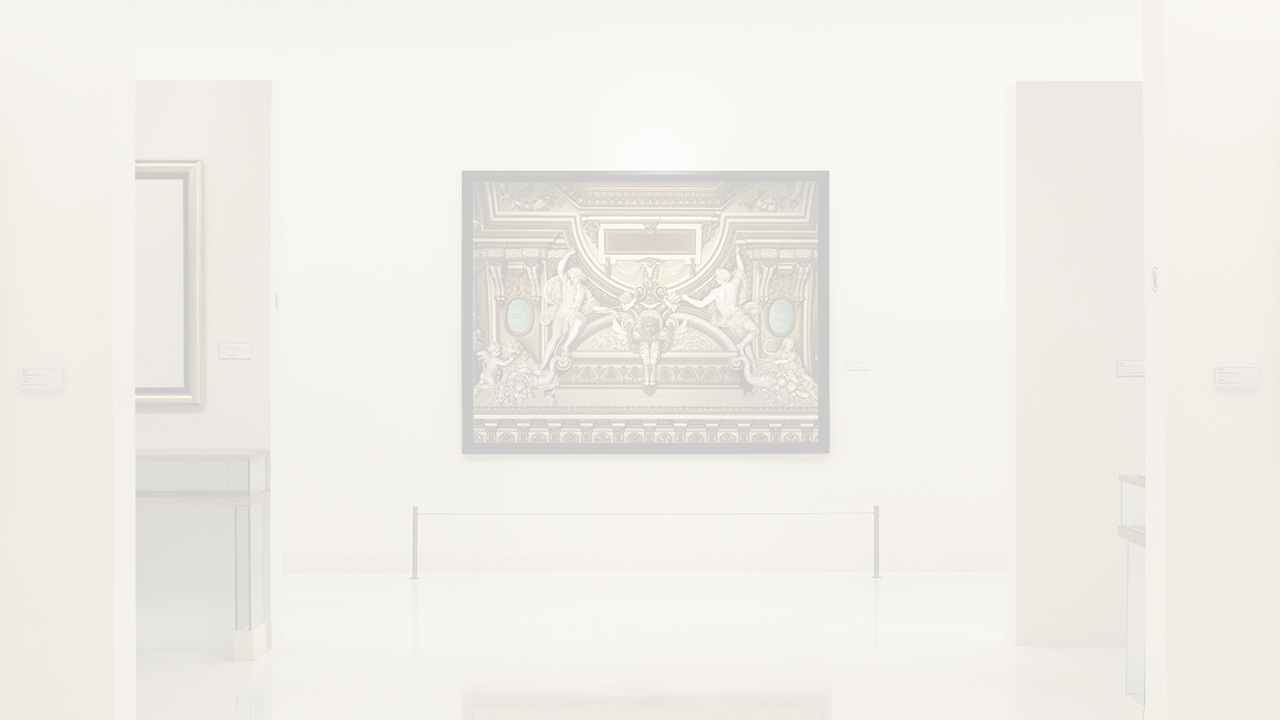Picture hanging is one thing, but styles of picture hanging are another. Among today’s most popular and well-known picture hanging styles is the way of the gallery wall.
You’ll know the gallery wall by its trademark density—the closeness of its pieces and a range spanned by mediums beyond fine art. You’ve probably had your fair share of gallery walls, at home, in art galleries, or in other spaces. But did you know that the gallery wall as it is today is the result of a history that goes back over three centuries and a half?

You can imagine the transformations a cultural staple such as the gallery wall would have undergone in that time. Academic ties, cramped salons, revolutions, and lighting arrangements—yes, there’s more to the gallery wall than the lifestyle trend it is known as in the 21st century.
In this article, we explore this rich evolutional chronicle in art and culture, closely intertwined with France’s political history itself, follow its reinvention in the centuries leading up to the present, and through it all, marvel at the hanging techniques that have, surprisingly, not changed much in all that time.
Are you ready? Let’s dive in.
Table of contents
The Salon Wall
When gallery walls were first created, they weren’t called gallery walls; they were known as salon walls. The term "salon wall" highlights differences from the modern gallery wall according to developments in art history, particularly in composition and the use of grid layouts.
The word salon in French simply means living room or room. And there’s our first hint—the gallery wall style of hanging began its story in France, in the late 17th century. We go back to 1667 Paris, when the Académie Royale de Peinture et de Sculpture launched an annual art exhibition in the Salon Carré of the Louvre Palace with the approbation of Louis XIV. The exhibit unveiled its first display of works of art crammed all over the walls of the Salon Carré, mainly for the benefit of aspiring artists who recently graduated from the École des Beaux-Arts. The exhibition was semi-publicly opened to aristocrats for these artists to gain patronage and acclaim.
Arrangement of their submissions followed two rules: first, that they adhere to a hierarchy of value with the most prized pieces placed “on the line” for optimal viewing, and second, that every bit of wall space was filled with art. This inspired each visitor to make the most of their viewing experience. Soon enough, the venue of this art exhibition became synonymous with the presentation of the artwork, referred to colloquially in the art world over time as the “salon hang.”

This presentation style became the basis of the gallery wall layout we know and love today.

The salon placement hardly discriminated between art styles and subject matter, and instead centered the most celebrated works, often the grandest in scale and depicting moments from history. Works of less consequence, such as landscapes, still lifes, and portraits, were relegated to the uppermost and lower areas surrounding these successful paintings.
From the mid-18th century to the late 19th century, the Salon was widely known as the greatest and most prestigious annual or biennial event in the Western art world.
A Bastion of Social Progress
The salon wall was influential, but not the norm. It began as a break from classical yet stiff French court standards, but it would soon unfold as a complete departure altogether.
By 1737, seventy years since the first Salon exhibit, the Académie shifted from its semi-public arrangement of the Salon to fully opening it to the public. This was a move that liberated art from the strict and exclusive confines of French aristocracy, and consequently liberated the French masses from a division of culture, particularly the appreciation of it, by class.
From thereon, salons became the first public art displays. Art as a whole was a cultural touchstone and became even more so with public access to the Salon and the invention of the public art museum. This desire for more cultural enrichment was nurtured alongside growing discontent toward the monarchy.

Soon, people put up their own salon exhibits outside the Salon Carré all over France, which served as cultural hotspots to people of all classes as well as avenues for class consciousness where Enlightenment thinkers and radical proponents assembled. The spirit of the Salons roused the revolutionary spirit and vice versa, and the movement became irrevocably entangled in the upheaval of the French Revolution at the end of the 18th century.
Beyond France
In the meantime, the middle of the 18th century witnessed the spreading influence of the Salon on the rest of the Western world. Europe closely followed the Salon fashion so that in 1769, the Summer Exhibition by the Royal Academy of Art in London, a collection showcasing the artistic spirit of the times, was launched in the now classic wall-to-wall layout. To this day, the Summer Exhibition displays works salon style, never failing to preserve the appeal and impact of that first art exhibition over 250 years ago.


And so, the salon wall became a standard display style in European museums. The Musée du Louvre also took the lead in its adoption from the moment it was first established in the middle of the French Revolution in 1793. Many people who had the means recreated their own versions in their private residences, marking a beginning for the 21st-century equivalent of the practice today. Together with the advancements of the Industrial Revolution from the mid-18th century to the middle of the 1800s, the audience for the Salons and the market for these private salon walls expanded throughout Europe and the United States. Innovations in technology gave rise to commercial art—that is, art created for the purpose of advertising. Art was not spared by that era’s boom in mass-produced goods, which introduced graphic advertisements, posters, and lithographs, as well as affordable picture frames, reflecting the social mobility of the era and further democratizing what was for many centuries accessible only to the elite.
As the Industrial Revolution, which spanned close to a century, afforded classes of people more income and more time, it consequently created new generations of art collectors and enthusiasts among the masses. By the 1870s, almost two centuries since the inaugural Salon, Victorians would take a collection of chromos, family portraits, or other decor such as decorative plates and organize them into what they called an “art unit,” displays much more compressed to an area or areas of a room. These spotlighted their most prized pieces and clustered in pockets of space illuminated best in a room. Using picture wire, pictures placed higher tilted downwards and frames along eye level hung flat against the wall.
It was also in this decade that a group of artists called the Société Anonyme des Artistes, Peintres, Sculpteurs, Graveurs, etc. organized their first independent exhibition outside of the Salon, upsetting the Salon’s monopoly on which works of art merited praise and an artist’s market value and career prospects.

These artists were led by Claude Monet, Edgar Degas, and Camille Pissarro and would later be known as the Impressionists, putting into motion the first modern art movement and setting a precedent to the art world’s redirection toward non-traditional art styles and techniques. As more independent exhibitions were mounted and splinter Salons created, it was thus that the Salon’s institutional authority in art and culture began to diminish.
Across the Pond: The Gallery Wall
By the time a new century was on the horizon, the Salon had been one of the longest-running events to serve as an “intersection of art, society, and commerce.”
In the 20th century, the effects of the Industrial Revolution on the art world and the leisure class it produced, combined with the ravages of World War II in Europe, saw a shift toward the United States as a new center of artistic activity.
American Industrialists like J.P. Morgan and Henry Clay Frick began to curate personal art collections in the early 1900s, collections that transformed into their own museums, or, in the case of J.P. Morgan’s, propelled existing ones like the Metropolitan Museum of Art to global prestige. Many of these collections by the nouveau riche mirrored the salon hang in Europe in their living room or parlor displays.


Throughout the 1920s, the gallery wall was so popular that American millwork houses came with built-in picture rail molding. Private homes were also slowly being introduced to electrical systems, a process that began at the end of the previous century. This would impact the relevance and very form of the gallery wall in the coming decades.
Following a rise in accessible, inexpensive artwork around the mid-1900s and, in the US, an explosion of museums in the 30s and 40s, the gallery wall maintained its popularity, especially for private displays. In the 1960s, a DIY salon wall was a true element of the decade’s zeitgeist, and in the 80s and 90s, a gallery wall usually meant a curation of family photos. Throughout that later half of the 20th century, however, with light sources becoming much less limited and more readily available, the art world moved away from the gallery wall as a standard to more individual orientations of display, and it ultimately became a more commonly adopted display style in private spaces.
The Gallery Wall Today
In the 2000s, the gallery wall remained a constant in interior design, reaching a peak in popularity as recently as the 2010s. Much of the trend was to hang pieces in frames with the same finish and to carry over the 90s practice of showcasing family photos.

Today, the 2020s encourage something freer and more varied—an “eclectic aesthetic.” More people buy and collect art than ever before in human history. There are more artists, too, a wider range of affordability, and art lovers enjoy the largest market for more art styles and forms than we’ve ever known. In this present age, the gallery wall is defined by asymmetry, an organic look, something that comes together as one unit, but not by coincidence. In the spirit of the Salon’s frenzied all-in-one fashion, the modern gallery wall is not exclusive to paintings or fine art, but instead mixes styles and mediums that seem alien to one another.







(Left to right) Images courtesy of: Hector Sanchez, sansnovazuhause, Sarah Vanrenen, Hannah Puechmarin, Jeff Her, Laura Roland Interiors
You can build your own gallery wall too with the help of our handy step-by-step guide:
Today, while the salon wall is more commonly known as the gallery wall, we often still refer to salon walls and the salon hang. Over 350 years since that first Salon Carré exhibit, the essence remains the same—a gathering of art and culture that epitomizes both style and narrative in one without preference for any one medium, size, or art style.
Final thoughts
It is symbolic that the salon wall was once an offshoot of a rigid aristocratic standard of display for a few highly-coveted pieces by acclaimed artists that then became a shapeshifting element of history from the French Revolution and the Industrial Revolution to the advent of the modern electric system. This was all to finally transform into its present form, the gallery wall, a modern staple of many homes and personal lifestyles, where, quite literally, anything goes.
Do you enjoy gallery walls like us, or maybe you’re about to get into your very first gallery wall project? If you need a hand, you know what to do—leave us a message and we’ll be with you in a jiffy.
Happy hanging!





Leave a comment (all fields required)